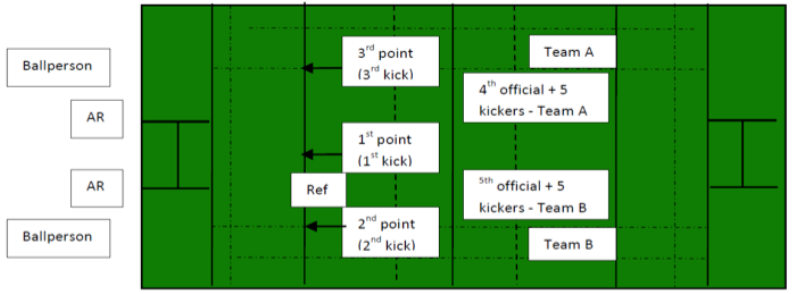
 As we head into the Super Rugby Finals Series, here is an overview of what happens should the scores be level at full time in any of our remaining matches.
As we head into the Super Rugby Finals Series, here is an overview of what happens should the scores be level at full time in any of our remaining matches.
(a) Extra Time – the procedure will be:
After a five minute rest period, the extra time is played in two 10-minute periods with a two minute half time;
Before extra time begins, the referee will do a coin toss with the two captains one minute before the new kick-off. The winner of the coin toss decides if his team wants to kick-off or if his team wants to choose the side of the pitch it wants to play on for the first 10 minute period;
For the second 10 minute period, the teams change sides and the team that did not kick off in the first period does so;
Coaches are not permitted on the field during the rest period or half time.
Teams and match officials must remain on the field during the rest period and at half time.
Injury time is added to the two 10 minute periods.
(b) Sudden Death – if the match is still tied at the end of extra time, the procedure will be:
An up to 10 minute sudden death period is played after another five minute rest period;
The first team to score (by a penalty, drop-goal or try) will be the winner;
As for extra time, one minute before sudden death begins, the match referee will do a coin toss to choose which team kicks off and on which side of the pitch they will play.
Teams and match officials must remain on the field during the rest period.
Injury time is added to this period of play.
(c) Kicking Competition – if the match is still tied at the end of sudden death, the referee will conduct a place kicking competition to determine the winner of the match, according to the following procedures:
All players and match officials will remain on the playing area. The referee will call the captains of the two teams together and will conduct a coin toss. The winner of the coin toss then may either choose which team kicks first (in which case the loser chooses the end at which all place kicks will be taken) or choose the end at which all place kicks will be taken (in which case the loser chooses which team kicks first).
Each team must nominate five players to take part in the competition. Only players on the playing area at the final whistle of extra time may be nominated. No substituted players, injury-replaced players or players who have been shown a red card may take part at any time. For clarification purposes, any player who has received a yellow card and who remains in the sin bin at the time of the final whistle of extra time may not take part in the place kick competition (including during ‘sudden death’). The order in which the nominated players will kick does not have to be pre-determined.
The match officials and the 10 nominated players (five from each team) will assemble on the half-way line. Team management and players not nominated must remain behind the half-way line in the side of the playing area not used. No one other than the match officials, the match manager, two ball persons and the participating players are allowed in the part of the playing area being used for the competition (including around the playing area, behind the posts, etc).
The five players from each team will place kick from three different points, all on the 22 metre line, as follows:
- First point: directly in front of the posts
- Second point: on the 15 metre line on the left hand side facing the posts
- Third point: on the 15 metre line on the right hand side facing the posts
The referee will start the competition by calling the first player selected from the team kicking first to the first kicking point. Once the player has taken the place kick, the referee calls a player from the opposing team to take his place kick from the same point.
The next two players (one from each team) will place kick from the second point in turn. This will continue until all five players from each team have place kicked (the next players place kicking respectively from the third point, the first point and finally the second point), or until one team is unable to equal the score of the other team within the remaining number of kicks (at which time the referee will declare the winner).
If there are an equal number of successful kicks once each team has completed its five place kicks, the competition continues on a ‘sudden death’ basis, following the same order of kickers used in the first five kicks.
The competition will continue two kickers at a time (one from each team), going progressively through the three kicking points as stated above (and repeating the process if necessary) until one player succeeds with a place kick and the player from the other team taking the same place kick misses it. Once this occurs, the team of the player who succeeded with the place kick will be declared the winner. Each of these additional kicks shall be taken by the same five players in rotation.
Throughout the place kicking competition:
- Once a player has positioned the ball on the kicking tee, he must take the kick within one minute. Should he take longer, the referee shall declare the kick unsuccessful.
- After each kick, the referee records the number of the player and whether or not the attempt was successful. The sideline manager/substitution recorder will record the same details on the official match report.
- Whether or not the kick is successful in each case is the sole decision of the referee, who may at his sole discretion rely on the assistance of his assistant referees. The referee’s decision shall be final and binding.
- Once a player has completed their place kick, they shall return to stand with their team behind the half-way line in the side of the playing area not used.
Please refer to the diagram below, which demonstrates the operation of the place kicking competition.
